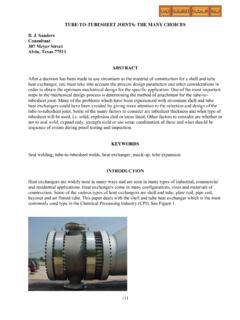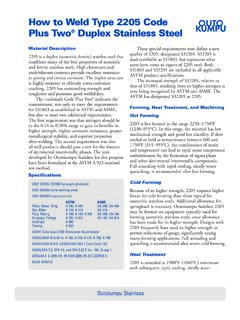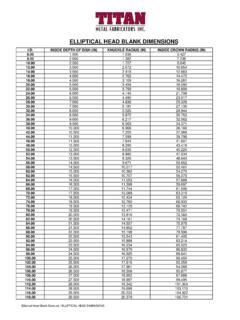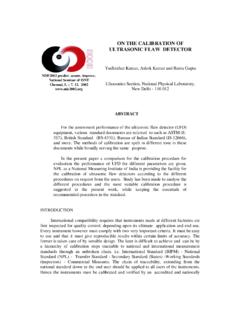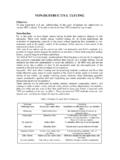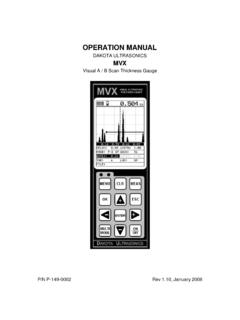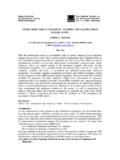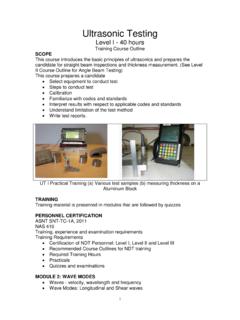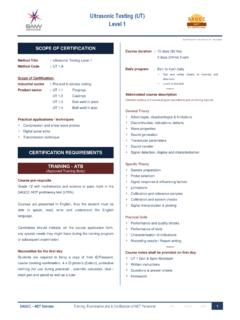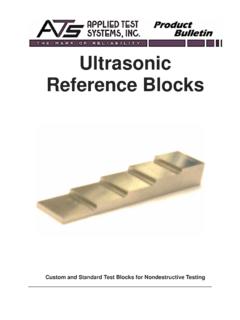Transcription of IRIS vs Eddy Current Testing - Titan Metal Fabricators
1 Eddy Current Testing vs. Ultrasonic iris for Inspection of Heat Exchanger Tubing Anmol Birring NDE Associates, Inc. email: 281 488 8944 Inspectors responsible for maintenance of heat exchangers are faced with the question on selection of the appropriate NDT technique. Two of the most common techniques are Eddy Current Testing (ECT) and Ultrasonic iris . Eddy Current Testing is based on measuring changes in probe impedance as the probe passes over the defects. The defect depth is estimated by comparing the ECT signal with the signals obtained from machined calibration defects. A calibration tube with well defined defects is made out of the same material as the material being inspected.
2 Depending on the equipment, ECT inspection can be conducted upto 60 to 72 inches/sec (5 to 6 ft/sec). A version of ECT called Remote Field Eddy Current Testing (RFECT) is used for inspection of carbon steel tubing. RFECT is relatively slow compared to ECT with a inspection speed around 12 inches per sec. Ultrasonic iris is performed using a focused ultrasonic probe and a rotating mirror that produces a helical scan. All data is taken with the tube filled with water. Ultrasound is reflected from the tube ID and OD and the time difference is used to calculate the thickness. Inspection speed is typically 2 to 4 inches/sec.
3 iris requires the tubes to be thoroughly cleaned for ultrasonic coupling. Both techniques have their advantages and limitations. Following data compares the performance of Eddy Current Testing (ECT) and Ultrasonic iris for inspection of heat exchanger tubes. This information was obtained from the report published by the Materials Technology Institute of Chemical Industries, MTI Project 123, St. Louis, 1999 (1). The report presents the capabilities of evaluated NDT techniques for tubing inspections. The data was taken using realistic, well characterized mock-ups. Tube Material ECT has high detectibility for all non-ferromagnetic materials.
4 These include stainless steels, titanium, hastelloy, brass etc. Table 1 shows that ECT detected 91 % of the defects in stainless steel while iris only detected 28 % of the defects. iris has higher detectibility for ferromagnetic materials such as carbon steel. iris detected 83 % of the defects in carbon steel while RFECT detected 67 % of the defects. The data is shown in Table 1. Table 1. Flaw Detection Performance by Material. The data show high detectibility of ECT for non-ferromagnetic materials and high detectibilty of iris for carbon steel. (Table 12 of MTI report) Material ECT iris Stainless Steel 91 % 28 % Titanium 98 % 68 % Ad.
5 Brass 92 % Not tested Cu-Ni 9010 91 % Not tested Carbon Steel 67% (RFECT) 83% Detection of Defect Types The data in Table 2 clearly shows that while iris is a good tool for detecting tube thinning and wear, it fails to detect common damage types in non-ferromagnetic materials. iris will fail to detect cracks in stainless steel, brass, hastelloy, inconel; MIC damage in stainless steel; pin holes in titanium, etc. The common types of defects in heat exchanger tubes are shown in Figure click here. Table 2. Flaw Detection Performance by Defect Type. Table shows high detectibility of ECT for small defects such as cracks, pits etc.
6 (Table 13 and 15 of MTI report) Defect Type ECT iris Pitting 90 % 67 % Cracks 93 % NA Tube Wear/Thinning 80 % 55 % Support Wear 93 % 93 % Large Volume Flaw 88 % 72 % Small Volume flaw 90 % 67 % Defect Sizing The MTI report also shows the sizing performance of ECT vs iris . ECT detected 91 percent of the defects in stainless steel and sized 47 percent within 10 percent of the actual size.
7 On the other hand, iris missed 72 percent of the defects in stainless steel. Of the 28 percent defects detected in stainless steel, iris sized 59 percent within 10 percent of the actual size. The performance of iris for sizing defects in titanium was poor as shown in Table 3. ECT detected 98 percent of the defects in titanium and sized 72 percent within 10 percent of the actual size. iris detected 68 % and was able to size only 32 percent within a tolerance of 10 percent of the actual size. The performance of iris was better than RFECT for carbon steel. iris detected 83 % of the defects and sized 51 percent within a tolerance of 15 percent of the actual size.
8 RFECT detected 67 % of the defects and sized only 33 percent within the of 15 percent. Table 3. Flaw Sizing Performance of iris vs. ECT. flaws sizing applies only to the flaws detected by the respective technique ( Table 16 of MTI report) Material Technique flaws detected Defects sized within tolerance (applies to detected defects only) Tolerance ECT 91 % 47 % 10 percent Stainless Steel iris 28 % 59 % 10 percent ECT 98 % 72 % 10 percent Titanium iris 68 % 32 % 10 percent RFECT 67 % 33 % 15 percent Carbon steel iris 83 % 51 % 15 percent Inspection Speed and Coverage The detectability (or coverage) of iris is also directly dependent on the pull speed.
9 iris is conducted using a rotating ultrasonic beam that results in a helical scan. With a inch spot diameter and a rotation speed of 32 rps, 100 percent coverage is achieved at a maximum pull speed of 2 inches per second. At a pull speed of 4 inches per second the coverage is reduced to 50 percent. ECT coverage depends on the sampling rate. At a sampling rate of 2000 samples/sec the inspection can be done at a speed of upto 72 inches/sec (6 ft/sec). Table 4. Other Factors. Speed of ECT is almost 30 times the speed of iris . iris also requires thorough cleaning of tubes. (Table 3 and 5 of MTI report) Other factors ECT iris Inspection Speed Upto 72 inches/ sec, can inspect almost 1000 tubes per shift inches/sec Cleaning Minimum tube cleaning to none Tubes must be thoroughly cleaned for deposits on the ID side Table 5.
10 Other Items. (not in MTI report) Other factors ECT iris U-tube inspection Yes, with flexible probe Not possible Insp. Coverage 100 % coverage. Includes 360 deg to full length. All data stored on hard disk for review Loss of data between the helical scans, poor UT coupling and operator attention. Data is typically not stored. Recommendations Based on the data, the following approach is recommended Non-ferromagnetic Materials, such as Stainless steel, Titanium, Brass, Cu-Ni alloys, Inconel should be inspected by Eddy Current Testing . ECT has high detectibilty and high inspection speed for non-ferromagnetic materials. Ferromagnetic Materials, such as Carbon Steel, can be inspected by iris or RFECT.


